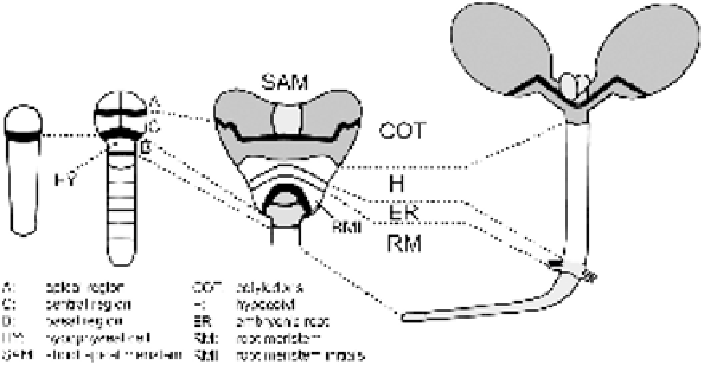Agriculture Reference
In-Depth Information
As the cellular organization of the meristem in an embryonic root is very similar
to that in the growing root, an important question was to determine if the cellular
organization of an embryo serves as the functional basis for that of the growing root.
To answer this question the fate of the descendents of
Arabidopsis
embryo cells
was determined using the clonal analysis technique. This technique depends on the
possibility to use a heritable genetic marker that can be traced in the descendents
of that cell. Since all descendents will possess this marker, they are considered
clones. Once the embryo has matured and germinated it can thus be determined
how much the original cell has contributed to the mature seedling. Factors such as
the size and distribution of the clonal area can be used to determine developmental
parameters such as cell division rates, founder cell number, etc. For shoot tissues
several markers are available, mostly involving intense staining with anthocyanins
or pigment loss due to chlorophyll deficiency; however, they do not function in
root tissues. Scheres
et al.
(1994) solved this problem by transforming a disrupted
β
-glucuronidase (GUS) gene under the 35S promoter into the
Arabidopsis
genome.
The GUS gene was disrupted with a maize
Ac
transposable element. Once this
excised an intact GUS, coding sequence was restored and blue staining could be
monitored in those cells where excision occurred. Using this technique Scheres
et al.
(1994) analysed large blue-stained clones that would demarcate the early embryonic
divisions. The larger the sector, the earlier the excision event must have occurred.
Since most of the sector boundaries either coincided or were closely associated with
embryonic cell divisions, they were able to establish a 'fate map', which predicted
the probable fate of embryonic cells (Fig. 8.2).
The embryonic boundary between root and hypocotyl was determined and this
separation was mapped to divisions at the early heart stage. However, since some of
Figure 8.2
Embryonic origin of the
Arabidopsis
root. From left to right: first zygotic division; octant
stage embryo; heart stage embryo; seedling. Adapted from Scheres
et al.
(2002).









